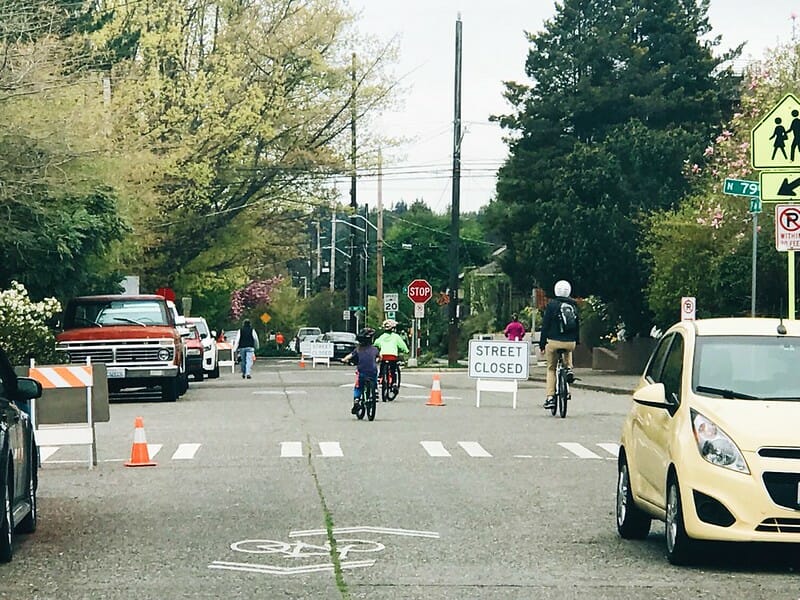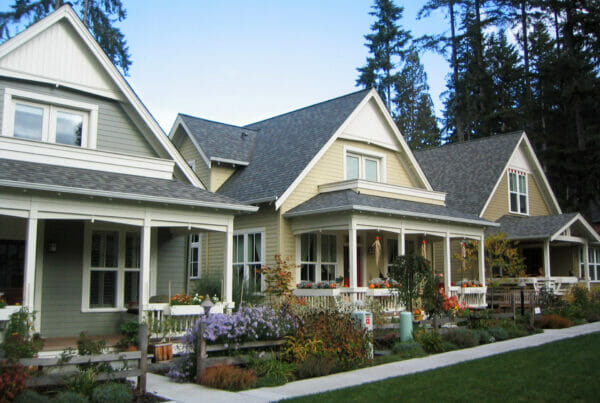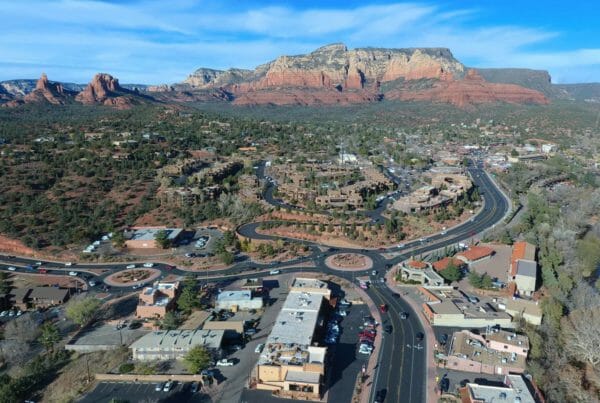As COVID-19 spread around the globe, communities and nations reacted in vastly different ways. The pandemic spurred lively discussion and debate around how the design of modern cities affects how contagious diseases are spread. There is also significant guidance – along with uncertainty – about how cities and towns should evolve as society reopens in the coming months and years.
We collected informative research, articles and opinion pieces on this topic and organized them in categories: urban design and density, equity, transportation, architecture, open space, housing, and business districts. Not all sources listed below are neutral or journalistic. We’ll keep this post updated as more information comes online.
Excellent resources for tracking the epidemic are the Washington State Department of Health, the New York Times’ interactive data dashboards, the visualizations at Our World in Data.
Washington state also collected a list of resources for businesses, and the city of Seattle posted Resources for the Community,
APA has developed a clearinghouse and list of resources for COVID-19 response, including GIS data and mitigation policies. Washington-specific resources for local governments are at the Municipal Research Services Center.
Urban design and density
A key question has revolved around population density: Does COVID-19 spread faster in more dense communities? The answer is not immediately obvious. Evidence to-date suggests the timing of economic restrictions, compliance with social distancing guidelines and public health system capacity have been much more important factors. Grocery stores, offices, religious facilities and other common gathering places can be just as crowded in rural and suburban towns as in major cities. We’ll explore more on this topic in a future post.
Nothing About New York’s Outbreak Was Inevitable
Henry Grabar at Slate
“A cursory look at a map shows that New York City’s coronavirus cases aren’t correlated with neighborhood density at all. Staten Island, the city’s least crowded borough, has the highest positive test rate of the five boroughs. Manhattan, the city’s densest borough, has its lowest. Nor are deaths correlated with public transit use. The epidemic began in the city’s northern suburbs. The city’s per capita fatalities are identical to those in neighboring Nassau County, home of Levittown, a typical suburban county with a household income twice that of New York City.”
Are Crowded Cities the Reason for the COVID-19 Pandemic?
Jason Barr and Troy Tassier at Scientific American
“For example, think of each city as a small forest of trees. Once lightning strikes anywhere in the city, the forest will burn until the wood runs out. Because dense cities have a larger value of contact rate of an individual C, they will burn a little faster and a little longer, but what happens in New York City will be replicated in cities across the country; New York City today will be Topeka or Tucson tomorrow.”
“The attention on the density of New York City and other large cities is misleading. The epicenter could have been anywhere. Lightning could have equally well struck in Chicago or St. Louis or Seattle first. Have we forgotten that it actually did land in Seattle first? In the second half of March we were focused on suburban New Rochelle, N.Y.—hardly the first city that springs to mind when one thinks of urban density.”
How Life in Our Cities Will Look After the Coronavirus Pandemic
Richard Florida, Edward Glaeser, Maimunah Mohd Sharif, Kiran Bedi, Thomas J. Campanella, Chan Heng Chee, Dan Doctoroff, Bruce Katz, Rebecca Katz, Joel Kotkin, Robert Muggah, and Janette Sadik-Khan for Foreign Policy
“What will our cities look like after COVID-19? Many of our favorite bars, restaurants, and cafes will be gone, but others will take their place. Elders and the immunocompromised may avoid urban spaces for a time, yielding a temporarily younger, fitter, more risk-tolerant downtown population. And the inevitable lingering fear of infection will be countered by a quarantine rebound effect: People will strain to get out from lockdown, hungry for the simple joys of being in fearless proximity with one another on a busy city street.”
How Will COVID-19 Affect Urban Planning?
Rogier van den Berg at TheCityFix
“How we plan our cities determines to a large extent how resilient they are. Population density without adequate public spaces or proper affordable housing provision will lead to problems. This was the reason many housing laws and regulations were implemented in Europe at the beginning of the 20th century, halting many diseases, for example.”
The Pandemic Pivot: How Coronavirus Might Shape Our City
Kinsee Morlan at KPBS
“Diseases can shape and shift cities. What mark will the coronavirus leave in its wake? What twists and turns will we take?”
In New York City, Density Saves Lives, Too
Nicole Gelinas at CityLab
“Even just basic exercise — walking home from the subway — keeps the average New Yorker healthier than most suburban Americans. Just 22 percent of adult New Yorkers are obese, according to the city’s health department, compared to the 42 percent rate for the U.S. as a whole, as reported by the CDC.”
Op-Ed: Dear Gov. Cuomo, The Problem Is Crowding, Not ‘Density’!
Brent Toderian at Streetsblog
“You can have density without crowding, and you can have crowding without density. We’ve seen examples of each during this pandemic.”
Can Urban and Rural Americans Get on the Same Page About COVID-19?
Zaid Jilani at Greater Good Magazine
“…People living in rural areas tend to have more tight-knit social networks—where visiting with your friends and family is common behavior. While consumers in urban areas often have many different locations to shop, a rural town may rely on a single Walmart for all of their essential goods. Rural church-goers also tend to be more regular in their attendance than people in urban areas.”
Equity
We adopt an equity lens on all our public-facing projects. The current pandemic has highlighted and perhaps widened gaps between the haves and have-nots, notably in the realms of employment security, digital and online access, childcare, family-sized housing and access to public services. The post-pandemic recovery will need to grapple with these pre-existing issues.
Coronavirus is not fuel for urbanist fantasies
Alissa Walker at Curbed
“If the coronavirus has made anything clear, it’s that cities cannot be fixed if we do not insist on dismantling the racial, economic, and environmental inequities that have made the pandemic deadlier for low-income and nonwhite residents.”
Location Data Says It All: Staying at Home During Coronavirus Is a Luxury
Jennifer Valentino-DeVries, Denise Lu and Gabriel J.X. Dance at The New York Times
“In cities across America, many lower-income workers continue to move around, while those who make more money are staying home and limiting their exposure to the coronavirus, according to smartphone location data analyzed by The New York Times.”
Who’s left riding public transit? Hint: it’s not white people.
By Transit at Medium
“We expected to see a surge in healthcare workers. What we also saw was a steep drop-off of white (and male) riders. Most of those left riding are women, and people of colour.”
As more people order delivery, workers fear virus exposure
Paul Solman at PBS
“More than 250 million Americans in 30 states have been asked or ordered to stay at home. Although some still buy essentials in person at stores, many are ordering online instead. As a result, warehouse and delivery workers and professional shoppers have become central to the current economy — and a growing number are concerned about the risks they face by doing their jobs.”
Social Distance Is a Social Justice Issue
Phillip Picardi at GQ
“The worst nightmare of public health officials like Dr. Mgbako is watching emergency rooms fill up with people who exist on the margins of society, whose long-term side-effects or deaths from COVID-19 were almost entirely avoidable. This will not be something confronted by the rich people who escaped to the Hamptons, or the upper-middle class people who stockpiled at Whole Foods and Trader Joe’s. It will be another trauma added to the list of the chronically ill, the uninsured, the undocumented, the disabled, the poor.”
Coronavirus pandemic exposes why America’s digital divide is dangerous
Daniel Castro at USA Today
“Millions of Americans, mostly in rural areas, do not have access to broadband at home. And nearly one in five Americans have access to the internet only through smart phones. The digital divide is concentrated among low-income individuals, many of whom are racial minorities.”
US coronavirus lockdowns drain parents, expose ‘digital divide’
Jihan Abdalla at Al Jazeera
“For families making a household income of $50,000 or less, 72 percent said they were at least somewhat concerned about their child falling behind academically, compared with 56 percent of parents from high-income households, according to a survey by the Associated Press-NORC Center for Public Affairs Research in late March.”
Transportation
Public transit ridership has plummeted 70%-80% in Seattle and other cities nationwide. Fare revenue and operator safety has been an immediate concern, while long-term recovery is expected to be difficult and disruptive. Meanwhile, the issue of pedestrian infrastructure and environmental benefits from reduced vehicle traffic is making headlines around the world.
Cutting Transit Service During the Pandemic: Why? How? And What’s Next?
Jarret Walker at Human Transit
“The most common quick response to the crisis has been to go to Saturday or Sunday schedules. This effectively does a bit of everything on the “difficult options” list. It’s totally reasonable as a quick response. Saturday and Sunday schedules already exist, have already been approved by both union and management, and are relatively easy to turn on.”
Europe’s Cities Are Making Less Room for Cars After Coronavirus
Feargus O’Sullivan at CityLab
“There is already an alarming pattern of correlation between high air pollution and high mortality rates for Covid-19, and Northern Italy has some of the nation’s worst air quality. Cities still battling a disease that frequently attacks the lungs will be reluctant to rely on a transit mode that does so much damage to air quality.”
Opinion: Coronavirus shutdowns are making it undeniably clear how toxic our car culture is
Matthew Fleischer at Los Angeles Times
“Less than a year ago, satellite data revealed Los Angeles’ notoriously dirty air was even filthier than was previously realized. Now, under Mayor Eric Garcetti’s “safer at home” order, the city has some of the cleanest air of any major urban population center in the world. And we can literally see, smell and even taste the difference.”
Man Creates Social Distancing Machine Because Social Distance Isn’t Hard Enough
James Crowley at Newsweek
“Rotsztain found that just about everywhere he went, the only place he could walk and maintain social distance was in the middle of the street. At the end of the video, he wrote that Toronto should limit most street access to cars. “Toronto needs more space for pedestrians to stay safe,” he wrote.”
Architecture
Never before have we spent so much time at home. The issue of residential design has become forefront for urban dwellers who lack private yards, and the pandemic may spur changes to other shared environments like offices and hospitals.
A Lesson from Social Distancing: Build Better Balconies
Linda Poon at CityLab
“There are a lot of benefits to balconies from the perspective of livability, lovability, mental health, and the enjoyment of living in urban settings — even before the pandemic,” says Vancouver-based city-planning consultant Brent Toderian. For one thing, “they connect homes in higher-density cities to the streets and to the outdoors.”
The Post-Pandemic Style
Vanessa Chang at Slate
“Sustainable urban design might instead combat vectors of contagion—litter, pollution, overcrowding—by encouraging people to think of public spaces more like home so they are invested in their care. Rather than denying our fundamental social connections, design might cultivate a deeper sense of global belonging.”
Smart lifts, lonely workers, no towers or tourists: architecture after coronavirus
Oliver Wainwright at The Guardian
“He imagines legislation might be introduced to mandate a minimum area per person in offices, as well as a reduction in maximum occupancy for lifts and larger lobbies to minimise overcrowding. All of this could have a big knock-on effect on the skyline. “High-rise buildings would become more expensive to build and be less efficient,” he adds, “which may reduce the economic attractiveness to developers of building tall – and super tall – towers both for offices and residential.”
Why nursing homes and senior living centers yield COVID-19 ‘perfect storm’
Amna Nawaz at PBS
“Remember, we don’t have testing. Many of these workers don’t have personal protective equipment, like masks or gowns or gloves, so they’re slowly spreading it throughout these buildings. And so it really is this perfect storm of lots of older adults with chronic illness and staff kind of slowly moving it around the building.”
How Infectious Disease Defined the American BathroomElizabeth Yuko at CityLab
“This isn’t a linear narrative with clear causation, but rather a convergence of advancements in science, infrastructure, plumbing, sanitation and design trends.”
Open space
We are missing the traditional opening of hiking and camping season on our statewide public lands. More locally, and also an equity concern, access to and quality of public parks and plazas has become a major issue as people grow restless and need space to spread out (especially parents with kids at home). Many cities are opening up streets to walking and bicycling to allow a safe breath of fresh air, and potentially some changes will be made permanent.
Seattle will close 6 more miles of streets to vehicle traffic to make space for pedestrians, bicyclists
Michelle Baruchman at The Seattle Times
“Seattle’s initiative follows efforts from other cities, including Denver and Philadelphia, to provide more space for pedestrians and bicyclists at a time when vehicle traffic in many areas has plummeted. Legislation proposed in New York City would close up to 75 miles of streets across all boroughs.”
A Tale of Two Truths: Transportation and Nuance in the Time of COVID-19
Ariel Ward at Medium
“This reflection is a call for more critical nuanced thinking within our profession — especially in the time of the COVID-19 crisis. This virus is exacerbating existing inequities as rapidly as it’s spreading. As seen on a national level, nuanced decision-making (or a lack thereof) can be the difference between life and death.”
The Power of Parks in a Pandemic
John Surico at CityLab
“The multiplicity of benefits parks have always offered us — physical and mental health relief, community building, and free public open space in tight, increasingly privatized urban quarters — seem not only like an added bonus right now, but rather, a critical lifeline for cities and their residents.”
In the coronavirus crisis, who gets to be outside?
Allisa Walker at Curbed
“In many ways, the efforts to protect residents from COVID-19 have demonstrated just how unevenly public space is distributed throughout urban America. While we are permitted to go outdoors under stay-at-home orders, whether it’s truly safe depends on where you live.”
Keep the Parks Open
Zeynep Tufecki at The Atlantic
“The outdoors, exercise, sunshine, and fresh air are all good for people’s immune systems and health, and not so great for viruses. There is a compelling link between exercise and a strong immune system. A lack of vitamin D, which our bodies synthesize when our skin is exposed to the sun, has long been associated with increased susceptibility to respiratory diseases.”
Public spaces in an age of social distancing: How to rethink parks after coronavirus
Andrew M. Manshel at New York Daily News
“We need to focus our resources on adequately stewarding of our existing public spaces, especially before expending valuable capital dollars on building new ones or rebuilding old ones. The most important ingredients to great outdoor social experiences are in their operation — and not necessarily in their design.”
Housing
The unemployment crisis is multiplied by millions of Americans struggling to pay rent and mortgages. Local and state governments are taking steps to help people remain in their homes. Analysis also indicates the homeownership market will not be impacted nearly as much as the rental market.
Inslee expands eviction moratorium and adds additional protections for residential and some commercial tenants
By the Office of the Governor
“The governor first proclaimed a moratorium on evictions in mid-March. The original moratorium applied only to dwellings that are captured in the Landlord Tenant Act, and prevented a landlord from evicting or seeking an unlawful detainer order…”
What Can State and Local Governments Do to Stabilize Renters during the Pandemic?
Solomon Greene, Martha Galvez, Corianne Payton Scally, Monique King-Viehland, Maya Brennan, and Samantha Batko at Urban Institute
“In the interim, state and local governments must plan for a COVID-19 “rent cliff,” or even the most aggressive federal relief efforts will be insufficient to stop widespread housing instability or evictions. Without intentional design and attention to infrastructure and capacity, states and cities risk overburdening existing systems that have seen declines in federal funding and that are already overtaxed.”
Housing Policy Must Change in Wake of COVID-19
Ingrid Gould Ellen, Katherine O’Regan, and Sophie House at Shelterforce
“The epidemic also reinforces the critical role that housing plays in protecting our health, safety, and well-being. Major housing policy reforms have historically grown out of health crises. Progressive reformers successfully pushed for regulations to improve the sanitation and ventilation of crowded tenements at the end of the 19th century after two major cholera outbreaks and concerns about high rates of other contagious diseases like tuberculosis in U.S. cities. During the 1930s, members of Congress highlighted public health as a central justification for the federal public housing program. This epidemic will offer its own lessons that could spur a new wave of thinking and a set of policies to advance housing security and equity.”
Airbnb’s COVID-19 crisis could be a boon for affordable housing
Steven Melendez at Fast Company
“One consequence of the sudden travel downturn could be a surge in units available for traditional rentals, which could potentially lower rental prices. However, experts caution it’s still too early to know how the market will shift in the long-term.”
How coronavirus is impacting the housing market
Jeff Andrews at Curbed
“Zillow conducted a study on housing during previous pandemics and concluded that while home sales dropped dramatically during an outbreak, home prices stayed about the same or suffered a slight decrease. This makes intuitive sense because it’s harder for prices to change when there are few transactions. In short, previous pandemics have simply put the housing market on pause.”
COVID-19 Policy Responses Must Consider the Pandemic’s Impact on Young Renters and Renters of Color
Jung Hyun Choi, Jun Zhu, and Laurie Goodman at Urban Institute
“Policymakers need to consider the impact on these hard-hit groups when designing and implementing new policies to respond to COVID-19. Many renters have received temporary eviction relief through the Coronavirus Aid, Relief, and Economic Security Act, but most have not. Moreover, eviction moratoriums do not pay the rent. Rental assistance could help many young renters and renters of color, who are likely to face great difficulty making their next housing payment.”
Business districts
The economic shutdown is nothing less than devastating to small businesses in communities of all sizes. While government support has been substantial, expect main streets and business districts to shrink in activity for the coming months and years. Planners have a major role to play in helping businesses recover through policy, regulations and programs.
Six Ways Planners Can Help Local Business in a Crisis
American Planning Association
“As businesses shift the way they operate, do what you can to support these new approaches. Being flexible with zoning and other policies by providing temporary loading zones for carryout pickups, allowing to-go alcohol sales, and keeping your permitting and inspection processes moving (as much as you can safely allow) will support those businesses that have found innovative ways to remain in operation.”
Renton, Kent, Burien and other South King County cities fear their small-town flavor could be lost to coronavirus pandemic
Melissa Hellman at The Seattle Times
“A likely outcome of the pandemic is that there will be a wave of small-business closures that will accelerate a trend of oligopolies in retail that was already happening,” Brookings Institution fellow Tracy Hadden Loh said.”
New Report: The Impact of COVID-19 on Small Businesses
Main Street America
“The findings are sobering: Millions of small businesses will be at great risk of closing permanently if the crisis continues for several months. Of the nation’s approximately 30 million small businesses, nearly 7.5 million small businesses may be at risk of closing permanently over the coming five months, and 3.5 million are at risk of closure in the next two months.”
Small Businesses Just Got a Big Lift, but Swift Implementation and Expanded Supports Will Be Key to Keep Them Afloat
Brett Theodos and Jorge González at Urban Institute
“Client-facing sectors like retail, lodging, and food services—some of the most affected by the crisis—are among the top three industries (PDF) for small businesses in terms of employment. In a recent survey, 76 percent of small business owners reported having been negatively affected by the coronavirus.”
Spokane planning looser rules so restaurants can expand seating into streets, sidewalks
Adam Shanks at The Spokesman Review
“A streatery and parklet are similar in concept, but different in functionality. They are both gathering spaces that temporarily occupy into as many as two public parking spaces or a loading area, but a streatery is operated by a sole restaurant, while a parklet is open to public use…Kinnear hopes to permanently strike down the requirement that an application for a streatery be subject to an administrative hearing, which is intended to offer an opportunity for public comment.”
Work From Home Is Here to Stay
Olga Khazan at Route Fifty
“Financial practicalities might speed up the work-from-home trend. After workers retreated to their homes, companies began desperately trying to shed office space. Getting rid of empty desks seems like an easy way to save cash as the economy collapses. Office real estate is already plunging in value as employers try to renegotiate their rent contracts.”






